The UK was the fastest growing fibre market in Europe last year and is forecast to expand rapidly over the coming half decade.
April 20, 2023

The UK was the fastest growing fibre market in Europe last year and is forecast to expand rapidly over the coming half decade.
A newly-published report from the FTTH Council Europe gives special mention to the UK, which seriously upped its game in the year to September 2022 – the council’s standard data deadline – and has continued to accelerate in fibre since.
The UK reached 42 percent fibre coverage as of September, up from 28 percent a year earlier, thanks to fibre builders passing an additional 4.2 million homes over the 12 months.
That makes it the biggest grower in Europe in terms of homes passed and helps to propel the market up the FTTH Council’s ranking tables. The UK is now fourth in the EU27+UK table in terms of the number of homes passed with FTTH/B at 12.4 million, ahead of Germany, and chasing Italy, Spain and France, the last being currently some way ahead. Adding Turkey into the mix in the EU39 table puts the UK down to fifth, incidentally.

In percentage terms, the UK was the second fastest-growing market last year at 51 percent, behind Belgium with 60 percent.
By next year the FTTH Council expects the UK to rank second in the table with 16.8 million homes passed, but by 2028 it drops back to third, following a forecast growth spurt from Germany which is set to take it to the top of the leaderboard.
But while there’s a lot to celebrate in the UK – and its progress can hardly come as a surprise given the number of fibre builders in the market bigging up their rollouts – there’s also plenty still to do. The UK has one of the largest populations in Europe, which naturally helps when it comes to FTTH absolute numbers. But penetration is still somewhat lagging, and the market is some way off full – or even high percentage – coverage.
The UK has 3.3 million FTTH/B subscribers, which ranks it fifth in the EU27+UK, a big improvement on last year. However, that means penetration is just 11.1 percent leaving the UK languishing near the bottom of the table still. Iceland leads at 76.8 percent, followed by Spain with 73.5 percent, the latter having made a big fibre push over a number of years.
As a result, only Germany has more work still to do than the UK to reach full fibre coverage. Germany has the best part of 33 million premises still to pass, while the UK has just over 17 million, although doubtless those numbers have changed since September last year, given the frenetic rate at which we’re seeing fibre rollout announcements from both countries.
The UK will continue to linger near the bottom of the table in penetration terms in the 2023 and 2028 data updates, the FTTH Council predicts. But the actual figures show a lot of progress, with the market reaching 43 percent penetration by 2028. Admittedly, at that time most countries will have passed the halfway mark – this year just seven of the EU27+UK markets have reached that milestone – and a dozen will be around or above the 75 percent mark.
But the fibre picture for the UK looks a lot brighter than it did a few years ago.
Get the latest news straight to your inbox. Register for the Telecoms.com newsletter here.
About the Author(s)
You May Also Like








.png?width=300&auto=webp&quality=80&disable=upscale)


_1.jpg?width=300&auto=webp&quality=80&disable=upscale)


.png?width=800&auto=webp&quality=80&disable=upscale)